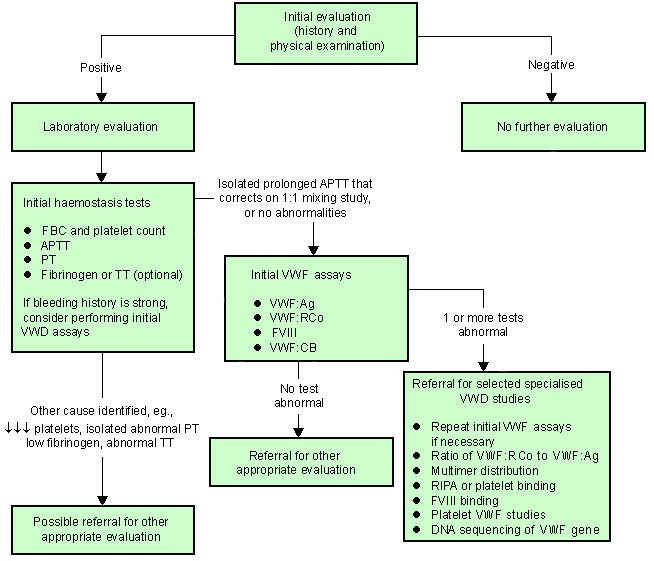Approach
History
Patients with type 1 VWD usually have easy bruising, excessive bleeding from minor wounds, and mucosal bleeding. Bleeding in infancy is rare, although young children may bruise more easily and have problems with nosebleeds, the latter being especially common in boys.[10] Girls may have menorrhagia from the onset of menarche. Excessive bleeding after procedures, especially those involving mucous membranes, such as tonsillectomy or wisdom tooth extraction, is common in both sexes.[11] However, patients with type 1 disease may not bleed with all procedures, and family history may vary.
In patients with type 2 or type 3 VWD, bleeding symptoms may begin at an earlier age than with type 1 and are often more severe. Patients with type 2A, 2B, or 2M disease usually have a clear family history of inheritance in an autosomal dominant fashion. However, patients with type 3 VWD usually have asymptomatic parents.
Patients with menorrhagia, chronic epistaxis, or gastrointestinal bleeding may give histories compatible with anaemia due to ongoing blood loss and iron deficiency.
A validated bleeding score - useful in determining the likelihood of an underlying bleeding disorder - has been published.[12] This assigns a score (from -1 to +4) for 12 bleeding symptoms. The overall score can theoretically range from -3 (for no spontaneous bleeding symptom and no bleeding after surgery, tooth extraction, and giving birth) to +45 for major bleeding for all symptoms. Some revisions do not include negative scores. ISTH/SSC: bleeding assessment tool Opens in new window
Physical examination
Physical examination may be normal. There may be signs of anaemia, such as pale conjunctiva. Bruises are a non-specific finding, but very large bruises or those found on the torso may be more significant. Evidence of joint bleeding may be seen in those rare patients with a markedly decreased factor VIII.
Laboratory evaluation
Initial laboratory screening of patients with symptoms of a bleeding disorder should begin with a prothrombin time, activated partial thromboplastin time (APTT), and FBC. FBC assesses anaemia and thrombocytopenia. In addition, fibrinogen level and thrombin time may be assessed optionally.
The bleeding time, used in the past as a screening test for platelet-dependent haemostasis, is neither sensitive nor specific enough to be useful in the diagnosis of VWD.[13]
Newer tests, notably the platelet function analyser (PFA-100), have better testing characteristics than the bleeding time, but are still not sensitive enough to exclude all cases of VWD.[14] Also, a specific diagnosis does not follow directly from an abnormal result, and further testing is needed: von Willebrand factor (VWF) antigen, VWF activity by ristocetin cofactor and collagen binding, and factor VIII activity should be ordered.[11] Developments in laboratory testing have made the assessment of VWF function more complicated and laboratories may employ several different assays.[15]
In types 1, 2A, 2B, and 2M VWD, factor VIII levels are variably decreased but not lower than the VWF antigen levels, unless a type 2N mutation is also present. In mild type 1 and in types 2A, B, and M VWD, factor VIII may not be low enough to result in a prolonged APTT, and thus a normal APTT does not exclude these diagnoses. In patients with abnormal results, a VWF multimer analysis may help with classification, especially when the activity is reduced relative to the antigen. Comparison of VWF antigen (VWF:Ag), VWF ristocetin cofactor activity (VWF:RCo), and VWF collagen binding activity (VWF:CB) may provide similar information. In patients with VWF dysfunction (activity:antigen ratio <0.6), platelet agglutination to low-concentration ristocetin should be measured; in type 2B VWD, sensitivity to this reagent is increased. Mutation analysis (gene sequencing), assays for antibodies to VWF, and platelet aggregation studies may be indicated in selected patients.
Because VWF is so variable in a patient, abnormal tests should be repeated and 2 concordant results obtained for definitive diagnosis. If the history or bleeding score indicates that an abnormality of haemostasis is present but initial tests for VWD are normal, further specific investigations for platelet, coagulation, or vessel wall abnormalities should be pursued. Testing and diagnosis during pregnancy is unreliable due to the associated increase in VWF synthesis.[2]
Diagnostic algorithm
[Figure caption and citation for the preceding image starts]: Diagnostic algorithm for von Willebrand disease. APTT: activated partial thromboplastin time; FVIII: factor VIII; PT: prothrombin time; RIPA: ristocetin-induced platelet agglutination; TT: thrombin time; VWD: von Willebrand disease; VWF:Ag: von Willebrand factor antigen; VWF:RCo: VWF activity by ristocetin cofactor; VWF:CB: von Willebrand factor collagen bindingAdapted from: National Heart Lung and Blood Institute (NHLBI). Von Willebrand disease (VWD): evidence-based diagnosis and management guidelines; 2008; used with permission [Citation ends].
Use of this content is subject to our disclaimer